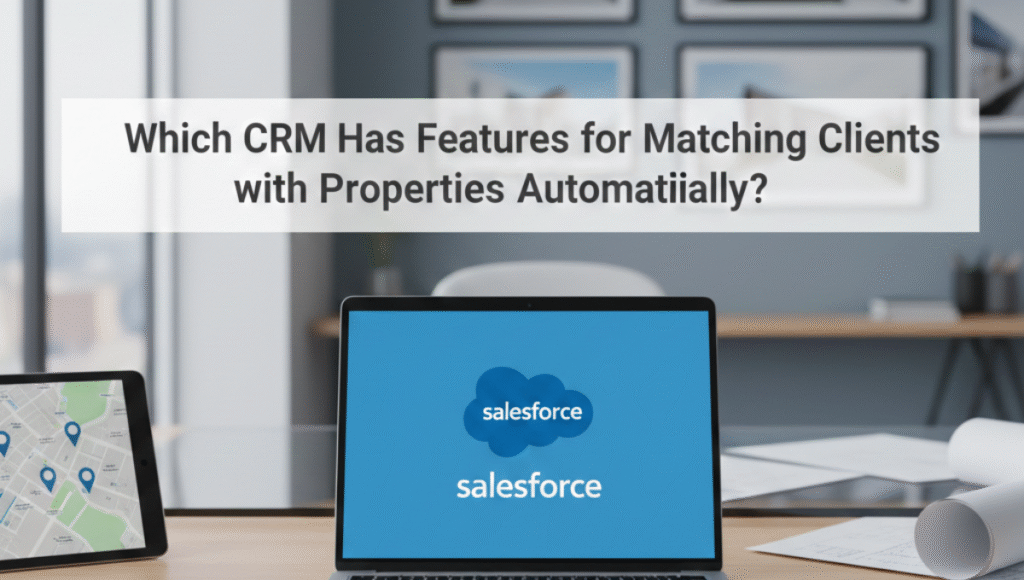
Finding the right property for a client can feel like searching for a needle in a haystack. You’ve got hundreds of listings, dozens of clients, and each person wants something different. What if your CRM could do this matching work for you?
Automated property matching has changed how estate agents work. Instead of manually searching through listings every time a client enquires, the right CRM system analyses client preferences and instantly shows matching properties. This technology saves hours of work and helps you respond to clients faster than your competitors.
Let’s look at which CRMs offer this functionality and how it actually works.
Automated property matching uses algorithms to connect clients with properties based on their specific requirements. When a new lead enters your system, the CRM analyses their budget, location preferences, property type, number of bedrooms, and other criteria. It then scans your entire property database and presents the closest matches.
This happens in seconds, not hours.
The technology goes beyond simple filtering. Modern systems track client behaviour too. If someone repeatedly views three-bedroom flats in Manchester with gardens, the CRM learns this pattern and prioritises similar properties in future searches.
Several CRMs have built property matching features directly into their platforms. Here’s what each one offers.
Salesforce doesn’t come with property matching out of the box, but it becomes a powerful matching engine when customised for real estate. Companies like Sailwayz specialise in implementing Salesforce solutions that include intelligent property matching workflows.
The system analyses customer interactions from calls and emails to match clients with properties they may be interested in. With Salesforce Einstein AI, the platform can score properties based on how likely they are to match what a client wants.
When customised properly, Salesforce can automatically assign leads to agents based on property type and location, then trigger property alerts when new listings match client criteria. This works particularly well for agencies that need customisation beyond standard real estate CRM features.
Qobrix lets you capture leads in the CRM and instantly view matching properties that meet required specifications. The system works in both directions. Upload properties and instantly view matching leads with whom to engage.
The platform uses location data to simplify searches. When capturing a lead, you can add multiple locations to instantly see matching properties. This helps agents working across different areas to quickly identify relevant listings for each client.
Qobrix also pushes listings to international portals like Zoopla and Rightmove, keeping everything synchronised across multiple platforms.
Property Raptor uses advanced AI to match properties and listings that prospects will love based on their profiles. The system analyses digital footprints from the moment leads reach out, automatically populating client profiles with useful insights.
For properties, you can track inventory and see your best suited clients for each listing. The platform offers data-driven recommendations by matching listings to clients with a higher likelihood to buy or rent, and vice versa. This bidirectional matching helps whether you’re starting with a new property or a new client.
Lofty automatically pulls in leads from various sources and sets up property alerts, sends out regular market analyses, and matches listings with leads. What makes Lofty different is its exclusivity feature. No other agent using the platform can target the same leads in your farm area.
The system combines lead generation with matching, so you’re not just matching existing leads but actively bringing in new ones who fit your property portfolio.
Real Geeks offers AI-powered automation throughout the lead workflow. The platform allows you to create automated property alerts and market reports whilst tracking leads’ behaviour on your website. When leads browse certain property types repeatedly, the system triggers automated follow-ups with similar listings.
The CRM includes a built-in IDX website that works alongside the matching engine, creating a seamless experience from property search to agent contact.
The matching process typically follows these steps:
Step 1: Data Capture When a lead fills out a form or contacts you, the CRM captures their requirements. This includes budget, location, property type, number of bedrooms, and any special features they mention.
Step 2: Profile Building The system creates a client profile with these preferences. More sophisticated systems analyse behaviour patterns too, noting which properties the client views, how long they spend on each listing, and which ones they save or share.
Step 3: Property Scanning The CRM scans your entire property database against the client’s criteria. It assigns match scores based on how closely each property aligns with what the client wants.
Step 4: Notification When a strong match appears, the system alerts you or sends automated property alerts directly to the client. Some platforms let you set match thresholds, so you only see properties above a certain compatibility score.
Step 5: Learning Each interaction trains the system. If a client rejects certain properties or shows interest in others, the CRM adjusts future matches accordingly.
Speed matters in property sales. By the time you find distressed properties, others have already made offers within 24 to 48 hours. Automated matching gives you instant alerts when seller motivation changes, letting you be first to market on every opportunity.
The technology also improves conversion rates. When clients receive properties that actually match what they’re looking for, they engage more. You’re not wasting their time with irrelevant listings, and you’re not wasting yours either.
For agencies managing large property portfolios, manual matching becomes impossible. You simply can’t remember which of your 50 active clients might be interested in a new three-bedroom terrace in Leeds. The CRM does this instantly.
Many agencies choose Salesforce as their foundation because it offers room to grow. When your business expands, Salesforce scales with you. Sailwayz helps agencies implement Salesforce with customised property matching workflows that fit their specific needs.
The platform enables automated appointment of leads to real estate agents based on their location, deal size, availability, and other factors. This means matching happens at multiple levels: matching properties to clients, and matching the right agent to each opportunity.
Salesforce also connects with MLS systems, email platforms, and marketing tools. When a new property enters the MLS, it automatically flows into Salesforce and triggers matching against your entire client database. Any matches generate immediate notifications.
Not all matching systems work the same way. Here’s what separates good ones from basic filtering tools:
Property matching isn’t perfect. Here are issues you might face and how to work around them.
Incomplete Client Data: Matching only works when you have accurate client information. If someone fills out a form with vague preferences, the system struggles. Train your team to gather detailed requirements upfront.
Changing Client Preferences: People change their minds. Someone initially looking for a flat might decide they want a house instead. Your CRM should make it easy to update client profiles so matching stays current.
Over-Reliance on Automation: The system provides matches, but you still need human judgment. Sometimes a property that doesn’t tick every box might still be perfect for a client because of intangible factors. Review matches before sending them to clients.
Data Quality Issues: Property databases need maintenance. If your listings contain outdated information, the matching engine will suggest properties that are no longer available. Regular data cleaning prevents this.
Getting started with property matching requires planning. Follow these steps for smooth implementation:
Audit Your Current Data: Before implementing any system, clean your existing property and client databases. Remove duplicates, update old information, and standardise how you record data.
Define Your Matching Criteria: Decide which factors matter most for matching. Budget and location are obvious ones, but you might also consider school catchment areas, parking availability, or proximity to transport links.
Choose the Right Platform: Pick a CRM that matches your agency size and growth plans. Smaller agencies might prefer ready-made solutions like Qobrix or Property Raptor. Larger agencies needing customisation might work with partners like Sailwayz to build Salesforce solutions.
Train Your Team: Your staff need to understand how the matching system works and when to override its suggestions. Hold training sessions covering data entry standards, how to interpret match scores, and best practices for following up on matches.
Monitor and Adjust: Track which matches lead to viewings and sales. If certain property types consistently generate poor matches, adjust your criteria. Most systems let you tweak matching algorithms based on real results.
Artificial intelligence makes matching more sophisticated. AI agents monitor property portfolios, automatically transfer contact and property data to CRM, qualify leads, and provide property analytics.
These systems go beyond matching existing criteria. They identify patterns you might miss. If clients from a certain profession consistently choose properties near specific amenities, the AI spots this trend and weights those factors more heavily for similar clients.
AI also handles natural language queries. Instead of filling out forms, clients can type “I want a dog-friendly house with a garden near good schools” and the system understands what they mean.
Pricing varies widely based on features and agency size. Basic property matching might cost £30 to £50 per user monthly. Platforms with AI capabilities typically start around £80 to £150 per user monthly.
Salesforce requires more upfront investment because of customisation work, but offers more flexibility long-term. Simple AI agents for real estate usually start at a few thousand pounds up to £25,000 for custom development.
Consider the return when evaluating costs. If automated matching helps you close even one additional deal per month, it likely pays for itself several times over.
Which CRM offers the best automated property matching for small agencies?
Qobrix and Property Raptor work well for smaller agencies because they include property matching features from the start without requiring extensive customisation. Both offer straightforward interfaces and affordable pricing that makes sense for teams under ten people. The systems handle bidirectional matching, letting you see which properties fit each client and which clients fit each property.
Can Salesforce handle property matching without customisation?
Salesforce requires customisation to handle property matching effectively. The platform doesn’t include real estate-specific features by default, but its flexibility makes it powerful once configured properly. Working with specialists like Sailwayz ensures you get matching workflows tailored to how your agency actually operates, rather than forcing your process to fit a rigid system.
How accurate is AI-powered property matching?
Accuracy depends on data quality and how well the system has been trained. Most AI matching systems achieve 70 to 80 percent accuracy initially, improving to 85 to 90 percent as they learn from successful matches and agent feedback. The key is reviewing suggested matches during the first few months and correcting the system when it gets things wrong.
Does automated matching work for commercial properties?
Yes, automated matching works for commercial real estate too. Systems like Salesforce with customisation from partners like Sailwayz handle complex commercial requirements including square footage, zoning, lease terms, and location-specific business regulations. Commercial matching often requires more sophisticated criteria than residential, but the technology handles both effectively when properly configured.
What happens to leads that don’t match any current properties?
Good CRMs don’t forget about leads without current matches. They stay in your database with their preferences recorded. When new properties arrive that fit their criteria, the system automatically sends alerts. Some platforms let you set up drip campaigns for unmatched leads, sending them market updates and new listings regularly until a suitable property appears.











Joshua Eze is the Founder & Salesforce Architect at Sailwayz, a certified Salesforce Consulting Partner based in the UK. With over 6 years of experience leading CRM transformations, he is a certified Application & System Architect passionate about using technology to simplify business processes. Joshua helps companies unlock the full potential of Salesforce with strategic, scalable, and secure solutions.